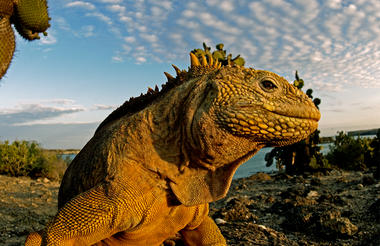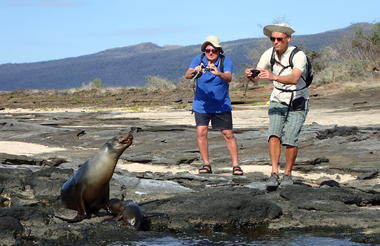AM: Arrival to Baltra Island
On arrival at Baltra Airport all visitors pay their entrance fee to the Galapagos National Park. You will then be met by The Beagle’s naturalist guide who will assist you with your luggage collection and accompany you on a short bus ride to the harbor to board The Beagle.
PM: Daphne Major & Minor Islands
Daphne Islands, a tuff cone (giant pile of compressed volcanic ash shaped like a cone), sits off the north coast of Santa Cruz Island, west of Baltra Island and North Seymour Island. While off limits to all but limited scientific parties going ashore, we've obtained permission from the National Park to navigate around the island, close by. You will have a front row seat to witness bustling colonies of blue-footed boobies, Nazca boobies, magnificent frigate birds and more. You'll also have the opportunity to observe short-eared owls and red-billed tropicbirds.



Daphne Major & Minor Islands
- Highlights: Blue Footed Bobbies, red-billed tropic birds, Finches, Short -eared owls, masked boobies, Galapagos martins
- Possible Activities: Panga ride
- Type of Landing: No landing
- Difficulty: Easy
AM: Santa Fe Island
One of the most beautiful coves of all visitor sites in the Galapagos, Santa Fe has a turquoise cove sheltered by a peninsula extending from the shore by a row of rock covered in Opuntia cactus and sea lions. This island was formed by an uplift caused by tectonic activity. You can see land iguanas, sea turtles, Galapagos hawks, sea lions, and a forest of giant Opuntia cactus, and it's lovely to swim and snorkel in the clear turquoise blue sea.
PM: South Plaza Island
South Plaza is one of the best spots in the Archipelago to see land iguanas and swallow-tailed gulls, both indigenous to the Galapagos. There are iguana nests scattered all over the hill. The sheer cliffs of the southern shore are a perfect bird habitat, making it an unparalleled bird observatory for especially swallow-tailed gulls, Audubon shearwaters, and red-billed tropicbirds.



Santa Fe
- Highlights: Sea lions’ colonies, Galapagos Hawks, cactus forest with giant Opuntia, arid zone vegetation, Scalesia helleri, land Iguanas, Galapagos snakes, sea turtles, and tropical fish
- Possible Activities: Nature hikes, snorkeling and kayaking
- Type of Landing: Wet landing
- Difficulty: Moderate
South Plaza
- Highlights: Sea lion colony, land iguanas and cactus forest, Sesuvium-Portulaca vegetation, cliffs with swallow-tailed gulls, red-billed tropicbirds, Masked boobies, blue-footed boobies, Audubon shearwaters, sally lightfoot crabs, manta rays
- Possible Activities: Uplifted Island trail, snorkeling, panga ride
- Type of Landing: Dry Landing
- Difficulty: Easy / Moderate
AM: Genovesa Island – El Barranco (Prince Philip’s Steps)
After a dry landing, you climb up the fairly steep Prince Philip’s Steps that take you onto a lava rock trail leading you through Palo Santo forest full of nesting birds. There’s a good chance of seeing the unique short-eared owl at this site.
PM: Genovesa Island – Darwin Bay
After lunch and a snorkel along the amazing cliff sides, you visit the beach area of Darwin Bay, home to frigate birds, red-footed boobies, Nazca boobies, flycatchers, lava gulls, storm petrels and Darwin finches, to mention some of the birds found in this bay, formed from a caldera collapse.



Genovesa
- Highlights: Fur seals, tropicbirds, storm petrels, great frigatebird, red-footed booby, masked booby, doves, finches, short-eared owls large tropical fish
- Possible Activities: Nature hikes, snorkeling, panga rides, kayaking
- Type of Landing: Dry landing.
- Difficulty: Moderate
Darwin Bay
- Highlights: Coral Beach, Swallow-tailed gulls, sea lions, red-footed booby, masked booby, large ground finch, large cactus finch, sharp-billed ground finch, small marine iguanas, great frigatebird, Galapagos Dove, yellow-crowned herons, lava herons, lava lizards, lava gulls, pintail ducks
- Possible Activities: Nature hikes, snorkeling, panga rides, kayaking
- Type of Landing: Wet Landing
- Difficulty: Easy / Moderate
AM: Fernandina Island – Espinoza Point
Fernandina is the youngest island of the Archipelago. As you disembark at Punta Espinoza, you must be careful not to step on the marine iguanas piled up together to retain body heat. This visiting site is rich in wildlife, sea lions, flightless cormorants, penguins, herons, Sally light-foot crabs and much more, all living side by side on this small point with its mangrove forest.
PM: Isabela Island – Urbina Bay
Located to the south at the foot of the western side of Alcedo Volcano, Urbina Bay was uplifted in 1954 from the seabed leaving coral heads sitting out of the water. There is a large colony of land iguana, which has grown since the feral dogs and goats have been controlled through Project Isabela. It also affords an opportunity to see the Alcedo Volcano tortoise in its natural habitat.



Espinoza Point
- Highlights: Marine Iguanas, flightless cormorant, sea lions, penguins, Galapagos hawk, Brachycereus cactus, aa lava, turquoise-blue zayapas crabs, blue and lava herons, sea turtles
- Possible Activities: Nature hikes and snorkeling
- Type of Landing: Dry landing
- Difficulty: Moderate
Urbina Bay
- Highlights: Uplifted corals from 1954, marine iguanas, flightless cormorant, dramatic landscape, tropical fish, sea turtles, land iguanas, giant tortoises
- Possible Activities: Nature hikes & snorkeling
- Type of Landing: Wet landing
- Difficulty: Moderate / Easy
AM: Isabela Island – Tagus Cove
The 30 minute hike at Tagus Cove takes you to the top of a cliff to view the volcanic landscapes of Darwin Volcano and Darwin Lake, the latter an uplifted ultra-saline lake saltier than the sea. Historically used as an anchorage site by pirates and whalers, this site is again an excellent place for marine and land birds.
PM: Isabela Island – Vicente Roca Point
Punta Vicente Roca offers a dinghy ride, excellent for marine life observation, to a snorkel area where underwater wildlife take full advantage of the nutrient-rich Cromwell current that upswells in this area.



Tagus Cove
- Highlights: Tuff cone formations, ash deposits, salt lake crater, historical graffiti, view of Darwin Volcano, arid zone vegetation, flightless cormorant, Galapagos penguins, finches, blue-footed boobies, brown noddies, pelicans, tropical fish, marine iguanas, sea turtles
- Possible Activities: Nature Hikes, Snorkeling, Panga Ride & Kayaking
- Type of Landing: Dry landing
- Difficulty: Moderate / Difficult
Vicente Roca Point
- Highlights: Masked boobies, blue-footed bobbies, flightless cormorants, sea lions, turtles, spotted eagle rays, manta rays puffer fish
- Possible Activities: Snorkeling and panga ride
- Type of Landing: No landing
- Difficulty: Easy
AM: Santiago Island – Espumilla Beach
Today visitors to Espumilla Beach come in search of birds rather than freshwater. The short walk up the beach leads inland to a mangrove typically inhabited by the Common stilts. Beyond the mangroves is a brackish lagoon where flocks of pink flamingos and white-cheeked pintails wade in search of mollusks.
PM: Santiago Island – Egas Port
After a wet landing at Puerto Egas, also known as James Bay, onto a black beach, an easy stroll takes you near the coastline to observe tidal pools, marine birds, iguanas, and sea lions, and often migratory birds are present in this area. This is also a good place to observe the Galapagos hawk. The trail ends at the fur sea lion grottos and, being nocturnal feeders, the fur seals sleep in and around the grottos during the day. On returning to the beach visitors may snorkel or swim.



Espumilla Beach
- Highlights: Flamingo Lagoon, ducks, stilts, some waders, mangroves, palo santo forest, sea turtle nesting site
- Possible Activities: Walk inland to transition zone vegetation, snorkeling, panga ride, kayak
- Type of Landing: Wet landing
- Difficulty: Easy
Egas Port
- Highlights: Fur seal, intertidal life, shorebirds, marine iguanas, sea lions, Darwin finches, Galapagos hawks, Galapagos doves, flamingos, vermillion flycatcher, woodpecker finch, sea turtles, occasionally golden rays, spotted eagle rays
- Possible Activities: Walk along coast to fur seal grotto, snorkeling and swimming, walk to salt mine
- Type of Landing: Wet landing
- Difficulty: Easy / Moderate
AM: Santa Cruz Island – Charles Darwin Research Station
The Charles Darwin Research Station is on Santa Cruz Island which is the main inhabited island in the archipelago, with a population of approximately 16,000. A visit to the station will increase one's understanding of the work being done by the foundation and the importance of preserving the Archipelago's ecosystems. A series of walkways takes you through the captive breeding program where you will see juvenile and adult tortoises from different islands.
PM: Santa Cruz Island – The Highlands
A highlight of any trip to the archipelago is a visit to the Santa Cruz Highlands, where the sparse, dry coastal vegetation transitions to lush wet fields and forests overgrown with moss and lichens. Our afternoon destination is the Wild Tortoise Reserve where we will have chances to track and view these friendly ancient creatures in their natural setting.



Charles Darwin Research Station
- Highlights: Van Straelen Exhibition Hall, giant tortoise pens, tortoise raising house, arid zone vegetation, Darwin`s finches.
- Possible activities: Walk
- Type of Landing: None (in town)
- Difficulty: Easy
Santa Cruz Highlands
- Highlights: Tortoise Reserve, lava tubes, Darwin`s finches, vermillion flycatcher
- Possible Activities: Walking and hiking
- Type of Landing: None (visit from town or airport)
- Difficulty: Easy / Moderate
AM: San Cristobal Island – Interpretation Center
In 1998 the Galápagos National Park Visitor Centre opened for the benefit of islanders and travelers alike, presenting a comprehensive exhibit of the islands’ natural history, human interaction, ecosystems, flora, and fauna.
Transfer to Airport
Your guide will take you to the airport in a bus, a ten-minute ride.



Interpretation Center
- Highlights: Natural and Human history of the islands
- Type of Landing: None (In town)
- Difficulty: Easy
Transfer to San Cristobal Airport



